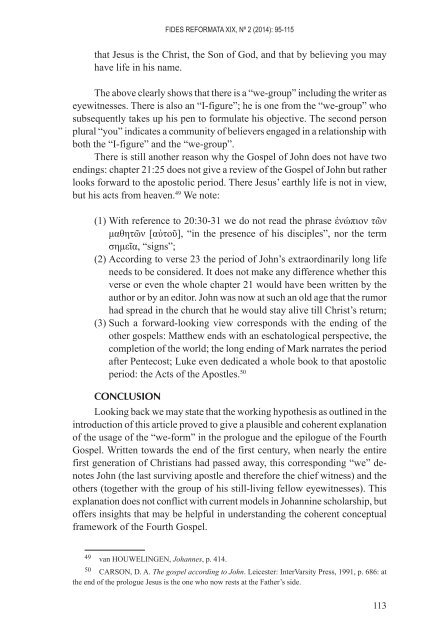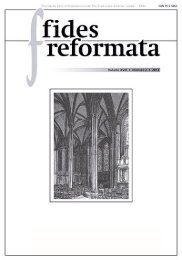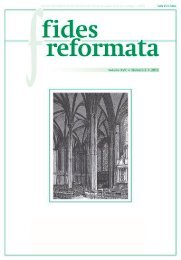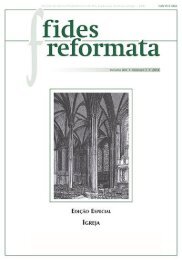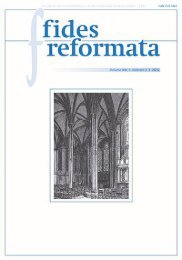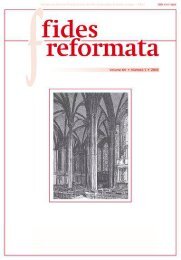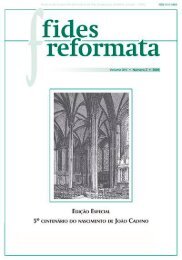Create successful ePaper yourself
Turn your PDF publications into a flip-book with our unique Google optimized e-Paper software.
FIDES REFORMATA XIX, Nº 2 (2014): 95-115<br />
that Jesus is the Christ, the Son of God, and that by believing you may<br />
have life in his name.<br />
The above clearly shows that there is a “we-group” including the writer as<br />
eyewitnesses. There is also an “I-figure”; he is one from the “we-group” who<br />
subsequently takes up his pen to formulate his objective. The second person<br />
plural “you” indicates a community of believers engaged in a relationship with<br />
both the “I-figure” and the “we-group”.<br />
There is still another reason why the Gospel of John <strong>do</strong>es not have two<br />
endings: chapter 21:25 <strong>do</strong>es not give a review of the Gospel of John but rather<br />
looks forward to the apostolic period. There Jesus’ earthly life is not in view,<br />
but his acts from heaven. 49 We note:<br />
(1) With reference to 20:30-31 we <strong>do</strong> not read the phrase ἐνώπιον τῶν<br />
μαθητῶν [αὐτοῦ], “in the presence of his disciples”, nor the term<br />
σημεῖα, “signs”;<br />
(2) According to verse 23 the period of John’s extraordinarily long life<br />
needs to be considered. It <strong>do</strong>es not make any difference whether this<br />
verse or even the whole chapter 21 would have been written by the<br />
author or by an editor. John was now at such an old age that the rumor<br />
had spread in the church that he would stay alive till Christ’s return;<br />
(3) Such a forward-looking view corresponds with the ending of the<br />
other gospels: Matthew ends with an eschatological perspective, the<br />
completion of the world; the long ending of Mark narrates the period<br />
after Pentecost; Luke even dedicated a whole book to that apostolic<br />
period: the Acts of the Apostles. 50<br />
Conclusion<br />
Looking back we may state that the working hypothesis as outlined in the<br />
introduction of this article proved to give a plausible and coherent explanation<br />
of the usage of the “we-form” in the prologue and the epilogue of the Fourth<br />
Gospel. Written towards the end of the first century, when nearly the entire<br />
first generation of Christians had passed away, this corresponding “we” denotes<br />
John (the last surviving apostle and therefore the chief witness) and the<br />
others (together with the group of his still-living fellow eyewitnesses). This<br />
explanation <strong>do</strong>es not conflict with current models in Johannine scholarship, but<br />
offers insights that may be helpful in understanding the coherent conceptual<br />
framework of the Fourth Gospel.<br />
49 van HOUWELINGEN, Johannes, p. 414.<br />
50 CARSON, D. A. The gospel according to John. Leicester: InterVarsity Press, <strong>19</strong>91, p. 686: at<br />
the end of the prologue Jesus is the one who now rests at the Father’s side.<br />
113


